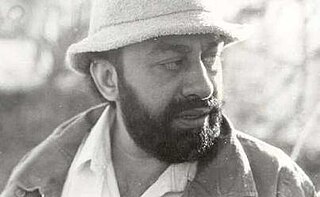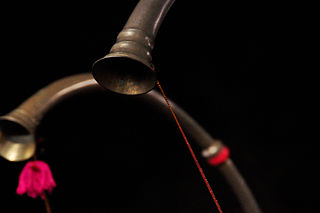
Malayalam, the lingua franca of the Indian state of Kerala and the union territories of Lakshadweep and Puduchery, is one of the six classical languages of India. Malayalam literature comprises those literary texts written in Malayalam, a South-Dravidian language spoken in the Indian state of Kerala. The first travelogue in any Indian language is the Malayalam Varthamanappusthakam, written by Paremmakkal Thoma Kathanar in 1785. Malayalam literature has been presented with 6 Jnanapith awards, the second-most for any Dravidian language and the third-highest for any Indian language.

Padmarajan Padmanabhan Pillai, better known as P. Padmarajan was an Indian film maker, screenwriter and author who was known for his works in Malayalam literature and Malayalam cinema. He was the founder of a new school of film making in Malayalam cinema, along with Bharathan and K. G. George, in the 1980s.
The Malayali people are a Dravidian ethnolinguistic group originating from the present-day state of Kerala in India, occupying its southwestern Malabar coast. They form the majority of the population in Kerala and Lakshadweep. They are predominantly native speakers of the Malayalam language, one of the six classical languages of India. The state of Kerala was created in 1956 through the States Reorganisation Act. Prior to that, since the 1800s existed the Kingdom of Cochin, the Kingdom of Travancore, Malabar District, and South Canara of the British India. The Malabar District was annexed by the British through the Third Mysore War (1790–92) from Tipu Sultan. Before that, the Malabar District was under various kingdoms including the Zamorins of Calicut, Kingdom of Tanur, Arakkal kingdom, Kolathunadu, Valluvanad, and Palakkad Rajas.

The music of Kerala has a complex history. It is not the same as Malayalam poetry, although most of it is poetry driven. Kerala has a rich tradition in Carnatic music. Songs formed a major part of early Malayalam literature, which traces its origin to the 9th century CE. The significance of music in the culture of Kerala can be established just by the fact that in Malayalam language, musical poetry was developed long before prose. With the development of music in the region, different branches were formed out of it.

Edasseri Govindan Nair was an Indian poet and playwright of Malayalam literature. Known as one of the major poets of Malayalam, Edasseri was a recipient of the Sahitya Akademi Award and the Kerala Sahitya Akademi Award for Poetry. He was also a recipient of Asan Smaraka Kavitha Puraskaram, which was awarded posthumously.

The Kombu or Kompu also known as the Kombu Pattu is a wind instrument in Tamil nadu and Kerala. Usually played along with Panchavadyam, Pandi Melam, Panchari melam etc. This musical instrument is usually seen in south India. The instrument is like a long horn.

The culture of Kerala has developed over the past millennia, influences from other parts of India and abroad. It is defined by its antiquity and the organic continuity sustained by the Malayali people. Modern Kerala society took shape owing to migrations from different parts of India and abroad throughout Classical Antiquity.

The Indian state Kerala is well known for its diverse forms of performing arts. The various communities in Kerala contribute to its rich and colourful culture. The most important traditional art forms of Kerala are Kathakali, Kalaripayattu,Mayilpeeli Thookkam, Koodiyattam, Theyyam, Mohiniyattam, Thullal, Padayani, Pulikali, Thiruvathirakali, Chakyarkoothu,Chavittunadakam, etc.

Konni, also spelt Konny, is a town and taluk headquarters in Pathanamthitta district of Kerala, India. Konni is known for its elephant cages, forests, and rubber plantations. It is also known as "Aanakoodinte Nadu". Nearest town is Pathanamthitta. Konni is located 32 km (20 mi) from Chengannur railway station and NH 183 in Chengannur. It is well-connected via Muvattupuzha - Punalur state highway. Buses ply frequently from Pathanamthitta KSRTC bus station to Konni.The natural beauty of Konni is truly captivating. Surrounded by lush greenery, Konni is nestled amidst the Western Ghats, offering breathtaking views of rolling hills, dense forests, and winding rivers. The landscape is adorned with teak and rubber plantations, creating a picturesque setting that's perfect for nature lovers and adventurers alike. The serene ambiance, coupled with the tranquil sounds of flowing streams and chirping birds, makes Konni a haven for those seeking solace in the lap of nature.It's known for its scenic beauty and serves as a gateway to the famous Sabarimala pilgrimage.Konni is not full of forests; there are developed towns there."

Madathil Vasudevan, popularly identified as M. V. Devan, was an Indian painter, sculptor, writer, art critic and orator. Besides his artistic works, he was also known for his architectural designs for a number of cultural institutions as well as for his contributions in founding Kerala Kalapeetom, Kochi-based cultural organization, Malayala Kalagramam, an art village in New Mahe and Kalagramam, another art village in Kollam. A former chairman of the Kerala Lalithakala Akademi, he was a recipient of several honours including the Raja Ravi Varma Puraskaram of the Kerala Lalithakala Akademi, the Vayalar Award and the Mathrubhumi Literary Award.

Karuvattu Mana Vasudevan Namboothiri, better known as Artist Namboothiri or simply Namboothiri, was an Indian painter and sculptor, known for his line art and copper relief works. He illustrated for many Malayalam writers such as Thakazhy Shivasankara Pillai, Kesavadev, M. T. Vasudevan Nair, Uroob, S. K. Pottekkatt, Edasseri Govindan Nair, and V.K.N., and was one of the most prolific literary illustrators of India. He was also a chairman of the Kerala Lalithakala Akademi. The Akademi awarded him the Raja Ravi Varma Award in 2003. He was also a recipient of the Kerala State Film Award for Best Art Director.
Ambalavasi, more properly Ampalavasi, is the generic name for a group of castes among Hindus in Kerala, India, who have traditionally rendered temple services.
P. Kunjanandan Nair, better known by his pseudonym, Thikkodiyan, was an Indian playwright, novelist, lyricist and screenwriter of Malayalam. He was known for his contributions to the genre of radio plays and his autobiography, Arangu Kaanatha Nadan, which detailed the socio-cultural development of Malabar in the post-independent period, fetched him a number of awards including the Kendra Sahithya Academy Award, Kerala Sahitya Akademi Award for Biography and Autobiography, Vayalar Award and the Odakkuzhal Award.

V. Madhusoodanan Nair is an Indian poet and critic of Malayalam literature, who is credited with contributions in popularizing poetry through recitation. He is best known for Naranathu Bhranthan, the poem with the most editions in Malayalam literature as well as his music albums featuring recitations of his own poems and poems of other major poets. Kerala Sahitya Akademi honoured him with their annual award for poetry in 1993. He is also a recipient many other honours including Sahitya Akademi Award, Asan Smaraka Kavitha Puraskaram, Padmaprabha Literary Award, Kunju Pillai Award, R. G. Mangalom Award, Souparnikatheeram Prathibhapuraskaram and Janmashtami Puraskaram.

Thottam Pattu is a ballad sung just before performing the Theyyam ritual. These are played in Theyyam temples before the commencement of Theyyam Art. Thottam Pattu is invocative. This is a mythological belief that by performing this ritual, the performer will be possessed by divine spirits. Thottam Pattu, the ritualistic songs which accompany the performance elaborate the legends related to the deities. Percussions such as Chenda and Thudi accompany the songs. Usually drummer men or make-up men or both of them perform the Thottam pattu by singing during the make-up.

Kalampattu is a traditional performing art in Kerala, India.

Narayanan Nambuthiri Kakkad, commonly known as N. N. Kakkad, was an Indian poet of the Malayalam language. Known for works such as Saphalmee Yathra, Pathalathinde Muzhakkam and Changatham, he was a Sanskrit scholar and was known to have been proficient in painting and music. He was a recipient of several awards including Odakkuzhal Award, Asan Smaraka Kavitha Puraskaram, Kerala Sahitya Akademi Award for Poetry and Vayalar Award.
Muhsin Parari, known professionally as Mu.Ri is an Indian film director, writer, producer and lyricist who works in Malayalam films.
Vijayarajamallika, known as Daivathinte Makal, is a transgender poet in Malayalam literature, She is a writer, teacher, social worker, inspirational speaker, and activist.

Old Malayalam, the inscriptional language found in Kerala from c. 9th to c. 13th century CE, is the earliest attested form of Malayalam. The language was employed in several official records and transactions. Old Malayalam was mostly written in Vatteluttu script. Most of the inscriptions were found from the northern districts of Kerala, those lie adjacent to Tulu Nadu. The origin of Malayalam calendar dates back to year 825 CE.













